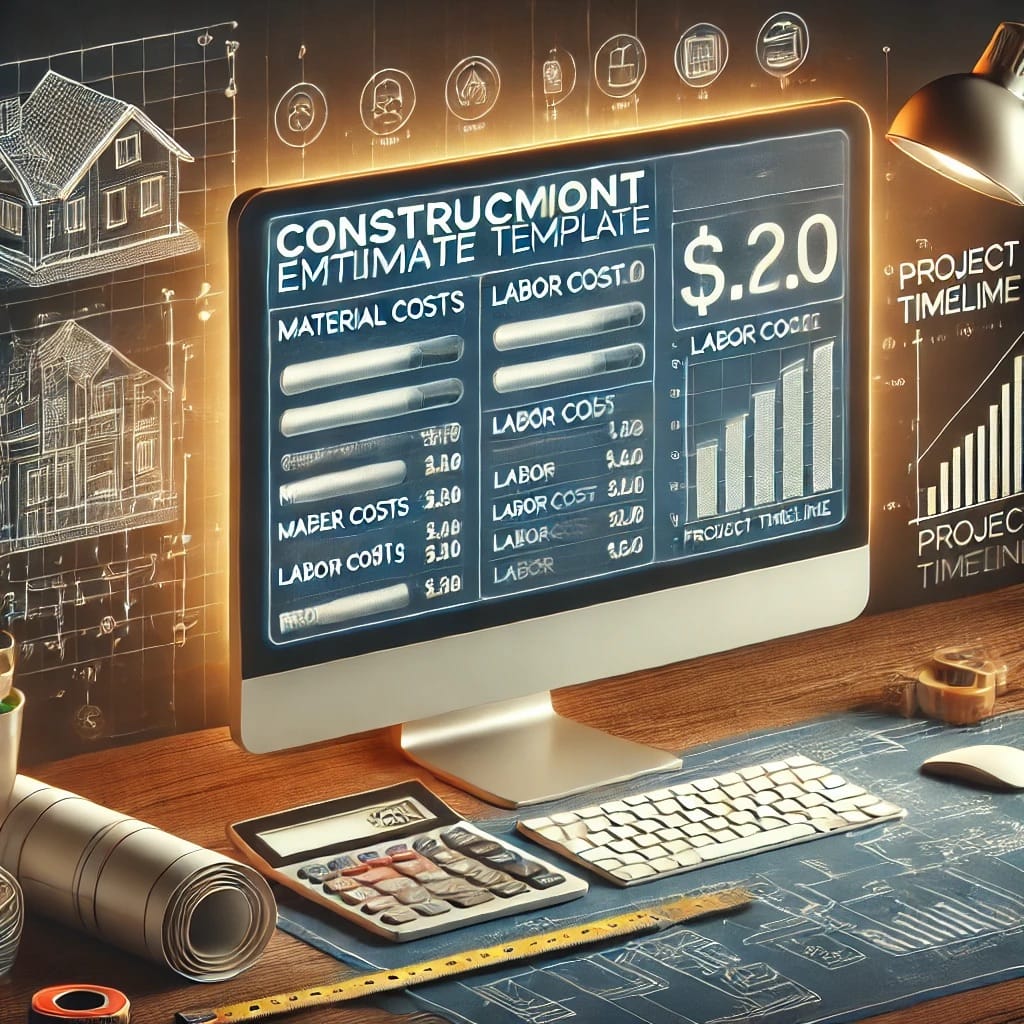Enhance Your Projects with a Construction Estimate Template

In the dynamic world of construction, accurate cost estimates are essential for a project’s success. A well-structured construction estimate template serves as the foundation for project planning, enabling contractors and project managers to manage resources, establish timelines, and control costs effectively. With construction projects involving numerous tasks, from material procurement to labor management, maintaining clear budget guidelines is critical. A comprehensive construction cost estimate helps prevent financial strain, ensures project feasibility, and maintains client trust, ultimately paving the way for a smooth and efficient construction process.

What is a Construction Project?
A construction project involves creating, modifying, or repairing structures and requires significant coordination across multiple disciplines, including architecture, engineering, and project management. Construction projects can be broadly categorized as:
- Residential Projects: Encompass homes, apartment buildings, and residential complexes, each requiring unique budgeting and scheduling considerations.
- Commercial Projects: Office spaces, shopping malls, and business complexes fall into this category. These projects often involve more complex infrastructure, larger budgets, and stricter timelines.
- Infrastructure Projects: Public utilities like roads, bridges, and airports demand extensive planning and are typically funded by government bodies.
Each project type has specific requirements, but all rely on careful construction project planning. A precise project estimate template aids in creating a realistic financial roadmap, covering everything from materials to labor and ensuring the project progresses without unexpected financial obstacles.
Key Elements in Construction Estimates
An effective construction estimate outlines every element necessary to bring a project from concept to completion. Let’s examine the critical components:
Tasks
Breaking down the project into major and minor tasks provides clarity on scope and simplifies construction management. Tasks may include foundational work, structural framing, plumbing, electrical installations, roofing, and finishing work. Listing tasks in an organized format aids in understanding each step’s resource requirements, cost implications, and scheduling needs.
Resources
Resources refer to all materials, labor, and equipment necessary for project completion. A detailed list of resources allows contractors to anticipate needs, negotiate better deals with suppliers, and prevent delays due to resource shortages. For example, concrete, steel, and wood are essential materials, while skilled labor, such as electricians and carpenters, may be required for various stages of the build.
Start/End Dates
Defining start and end dates for each task ensures that the project progresses smoothly. Scheduling tasks in sequence or overlapping where possible enhances productivity and reduces idle time for workers. Start and end dates also play a role in cash flow management, as expenses are phased in line with the project’s timeline.
Costs
Cost estimation is the cornerstone of a construction project. Accurately predicting construction costs helps ensure the project remains financially viable. Direct costs include materials, labor, and subcontractor fees, while indirect costs may cover administrative fees, transportation, and site utilities. By carefully considering both, contractors can create a balanced budget that accounts for all expenses.
Tax and Total Cost
In construction, taxes, fees, and profit margins must be included to reach an accurate total cost. A well-organized estimate accounts for all potential charges, ensuring clients and stakeholders have a clear understanding of the financial commitment involved. Adding these factors provides a realistic view of overall project expenses.
Signatures & Client Contact Information
For transparency and accountability, include spaces for client contact information and authorized signatures on each estimate. This formalizes the estimate as a binding document and allows easy access to contacts for clarification or approval during the project’s progression.
Types of Costs in Construction
A deep understanding of cost types is crucial for effective project budgeting. In construction, costs can generally be divided into:
- Direct Costs: Directly tied to project execution, covering expenses for materials, on-site labor, equipment, and any subcontracted work. Efficient direct cost management helps contractors stay within budget.
- Indirect Costs: Related to administrative activities, support staff, office expenses, and site security. These costs are essential to support operations but do not directly contribute to building.
In addition to direct and indirect costs, contractors must anticipate unexpected costs, which may arise due to weather conditions, supplier delays, or design changes. Planning for these unforeseen expenses by including a contingency in the estimate ensures the project remains financially secure.
Free Construction Estimate Templates
Several free estimate templates are available to simplify the creation of a comprehensive construction budget template. Here’s an overview of some useful template options:
Construction Estimate and Budget Template
Ideal for projects that require in-depth cost breakdowns by task, this template includes sections for labor, materials, equipment, and subcontractor fees. It provides a holistic view of the project, covering all essential elements of a cost estimation spreadsheet. Each task is listed with associated costs, and the template offers built-in formulas to calculate totals, tax, and profit margins.
Basic Contractor Estimate Template
This template is streamlined for fast, straightforward estimates. By offering a high-level overview, it’s perfect for pre-construction planning and is particularly useful when clients need a simple summary of projected costs without excessive detail.
New Home Construction Estimate Template
For residential projects, this construction estimate template provides a detailed cost breakdown. It includes progress tracking sections, allowing clients and contractors to monitor stages and associated costs. This template is ideal for tracking costs related to new builds, from foundation work to interior finishes.
Each template offers customizable fields and can be adapted to different project sizes and scopes, ensuring contractors can manage budgets with precision and ease.
Conclusion
In construction, managing finances is as critical as managing timelines and resources. A construction estimate template enables transparency, accuracy, and efficiency, helping project managers and contractors to communicate budget expectations clearly. By implementing a standardized template, construction teams can monitor expenses, streamline communication, and achieve their objectives within budget. Whether you’re handling a residential or commercial project, using a pre-designed estimate template is a strategic choice that ensures financial stability, enhances client trust, and contributes to the project’s overall success.
Source: Construction Estimate Template - [Learn How to Build Your Own]
Read also our last article: Change Requests in Project Management: Free Word Templates





